
N.V. Koolhoven was an aircraft manufacturer based in Rotterdam, Netherlands. From its conception in 1926 to its destruction in the Blitzkrieg in May 1940, the company remained the second major Dutch aircraft manufacturer. Although many of its aircraft were as unsuccessful economically as they were brilliant from a design standpoint, the company managed to score several 'hits', amongst them the FK-58 single-seat monoplane fighter, the FK-50 twin-engine passenger transport, and the FK-41, built in England under licence by Desoutter.

Koolhoven F.K.52 was a Dutch-designed, two-seat reconnaissance-fighter biplane, which was developed in the 1930s by Koolhoven. The aircraft was equipped with an enclosed cockpit and single-strut landing gear. Only six aircraft were produced. The aircraft saw some service in the Finnish Air Force.
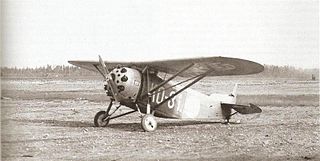
NVI F.K.31 was a Dutch designed parasol wing two seat reconnaissance-fighter, which was developed in the 1920s by Frederick Koolhoven. The aircraft saw some service in the Finnish Air Force.
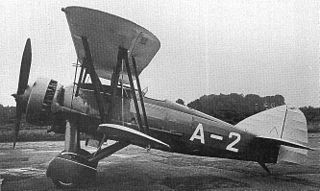
The Armstrong Whitworth A.W.16 was a single-engine biplane fighter aircraft designed and built by the British aircraft manufacturer Armstrong Whitworth Aircraft.
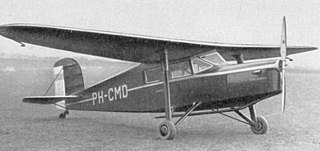
The Koolhoven F.K.43 was a small four-seat, single-engined monoplane passenger aircraft manufactured by Koolhoven in the Netherlands. It was a direct successor of the F.K.41.

The Koolhoven F.K.51 was a 1930s Dutch two-seat basic training biplane built by the Koolhoven Company.

The Koolhoven F.K.42 was a parasol-wing, two-seat training monoplane manufactured by Koolhoven in the Netherlands. Only one was built.
The Koolhoven F.K.40 was a small airliner built in the Netherlands in 1928 for KLM Royal Dutch Airlines. It was a conventional high-wing cantilever monoplane powered by a single engine in the nose. The fuselage was made of welded steel tube construction with a wooden wing skinned in plywood and held in place by four bolts to facilitate removal. The cabin was spacious for an aircraft of its size, and was intended to be readily reconfigured for passengers, mail, or freight. Although up to six seats could be fitted, the only F.K.40 built flew with four.

The Junkers T 19, originally known as the J 19, was a single-engined parasol winged all-metal 2/3-seat aircraft built in Germany in the early 1920s for training and touring. Its construction was too expensive for commercial success and only three were built, one later finding use as an engine test-bed.
The Koolhoven F.K.44 was a two-seat, single engine sport monoplane designed and built in the Netherlands in the early 1930s. It was built to order, but only one was completed.

The Koolhoven F.K.54 was a Dutch single-engine, three-seat touring aircraft with a retractable undercarriage. It flew shortly before the start of World War II and its development was abandoned after its first flight as attention turned to military aircraft.
The NVI F.K.29 was a small Dutch biplane transport, carrying two passengers who boarded after the nose, with its single engine and fuselage, had been swung open. It was intended to link small local fields to main airports.

The NVI F.K.32 was a tandem two-seat biplane training aircraft designed and built in the Netherlands in the mid-1920s. It did not go into service.

The NVI F.K.34 was a three-seat reconnaissance floatplane built in the Netherlands in 1925 as a private venture in the hope of a Dutch Naval Aviation Service order; two accidents during testing meant that it did not go into production.

The NVI F.K.35 or Koolhoven F.K.35 was a two-seat fighter aircraft built in the Netherlands during 1926. It was completed and exhibited but, through a combination of ground accident and financial problems, never flown.
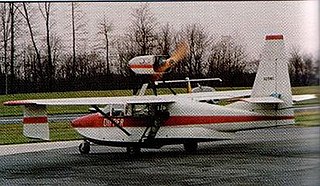
The Collins Dipper was an American homebuilt flying boat that was designed and produced by Collins Aero of Chadds Ford, Pennsylvania and first flown in 1982. The aircraft was supplied in the form of plans for amateur construction. Only one was built and none remain registered.
The Laron Wizard is an American homebuilt aircraft produced by Laron Aviation Tech of Borger, Texas. When it was available the aircraft was supplied as a kit for amateur construction.
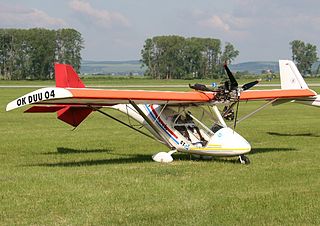
The Letov ST-4 Aztek is a Czech microlight aircraft that was designed and produced by Letov Kbely of Prague - Letňany, in the 1990s. When it was available, the aircraft was supplied as a complete ready-to-fly aircraft, or as a kit for amateur construction.
The Microleve ML 450 is a Brazilian microlight aircraft that was designed and produced by Microleve of Rio de Janeiro. When it was available the aircraft was supplied as a complete ready-to-fly-aircraft or as a kit for amateur construction.
The SEA.1 was a Belgian, multi-purpose, light twin engine monoplane flown in 1936. Only one was built; it was later converted into a single engine aircraft and used by the military.














